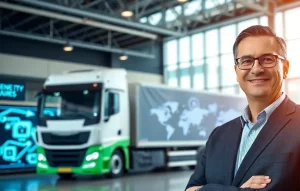
Fan Xianjun, CEO of Yuancheng New Energy Commercial Vehicles, stated that methanol-hydrogen electric technology is particularly suitable for northern regions. He noted that if half of the trucks in China switched to methanol as fuel, it could reduce oil imports by 125 million tons.
The China Electric Vehicle Hundred People Forum (2025) was held in Beijing from March 28 to March 30, focusing on the theme of “Strengthening Electrification, Promoting Intelligence, and Achieving High-Quality Development.” Fan Xianjun attended and delivered a speech, emphasizing the role of commercial vehicles as essential tools for economic development. He highlighted their connection to national livelihood and the implementation of the country’s energy security and dual carbon strategies.
Currently, the penetration rate of new energy in the domestic passenger vehicle sector has reached approximately 50%, while in commercial vehicles, it remains below 20%. Fan noted, “How to accelerate the low-carbon and intelligent transformation of commercial vehicles is a question we at Yuancheng are continuously exploring.”
Fan presented several key points during his address:
First, he emphasized that methanol-hydrogen electric technology aligns with China’s energy situation and security needs. He mentioned that China’s energy structure, characterized by abundant coal but limited oil and gas, results in a high dependency on foreign oil, with the reliance exceeding 72%. This dependency presents significant challenges to national energy security, particularly given that over 70% of the 700 million tons of oil consumed annually is used in transportation, with 51% going to trucks, translating to consumption exceeding 250 million tons per year. It is estimated that replacing half of the fuel used by trucks with methanol could reduce oil imports by 125 million tons.
Moreover, commercial vehicles contribute significantly to pollution, accounting for 56% of all automotive carbon dioxide emissions and 80% of PM pollutants. Thus, reducing emissions from commercial vehicles has become imperative.
Second, he asserted that methanol-hydrogen electric technology meets the diverse operational needs of commercial vehicles, especially in cold environments, ensuring stable range while balancing environmental and safety concerns. He identified pure hydrogen electric technology as the optimal solution for the electrification of commercial vehicles. This technology combines the advantages of methanol and electric power, utilizing methanol as the energy source along with a high-efficiency range extender that provides continuous power supply. Compared to pure electric models, methanol-hydrogen electric vehicles alleviate range anxiety and battery weight issues, increasing payload capacity while lowering overall vehicle costs. “This technology is particularly suited for the extremely cold northern regions, as methanol has a freezing point of -97.4°C and a boiling point of 64.7°C, providing the best temperature range among energy fuels, making it adaptable to all operational conditions and weather.
Third, he pointed out that pure hydrogen electric technology can continuously improve efficiency for the logistics sector, representing a new productive force in specialized new energy vehicles. Latest statistics show that in 2024, logistics costs in China accounted for 14.1% of GDP. Although this is a decrease from the previous year, it remains approximately double that of developed countries in Europe and America. With road transport comprising 72.4% of total freight transport, energy costs constitute a significant portion of road transport expenses. Therefore, the low energy cost of methanol-hydrogen electric technology provides an effective solution to reduce logistics costs, representing a new productive force and upgrading traditional automotive power-related industries.
Fourth, Fan highlighted that methanol-hydrogen electric technology can offer comprehensive solutions, maximizing customer benefits and enhancing the technology route for new energy commercial vehicles. He provided an example of a 49-ton heavy-duty truck powered by methanol-hydrogen electric technology, which consumes 72 liters of methanol per 100 kilometers. Assuming a methanol price of 2 yuan per liter, the operational cost for 100 kilometers would be 144 yuan. In comparison, a 49-ton hydrogen fuel cell truck consumes 8 kg of hydrogen per 100 kilometers, costing 280 yuan, while a pure electric truck uses 120 kWh per 100 kilometers, totaling 144 yuan. However, the procurement cost of a methanol-hydrogen heavy-duty truck is 15%-20% lower than that of a pure electric truck.
Fifth, he noted that methanol-hydrogen electric technology addresses existing pain points and bottlenecks in various new energy technology routes. In recent years, the exploration of new energy has largely focused on three mainstream routes: pure electric, hybrid, and hydrogen. Nevertheless, practical applications reveal that these mainstream technologies face various bottlenecks. “Methanol offers higher volumetric energy density and lower storage and transportation costs, and the technological patents and supply chains of pure electric vehicles are predominantly controlled by Chinese enterprises, providing a global competitive advantage,” he explained.







